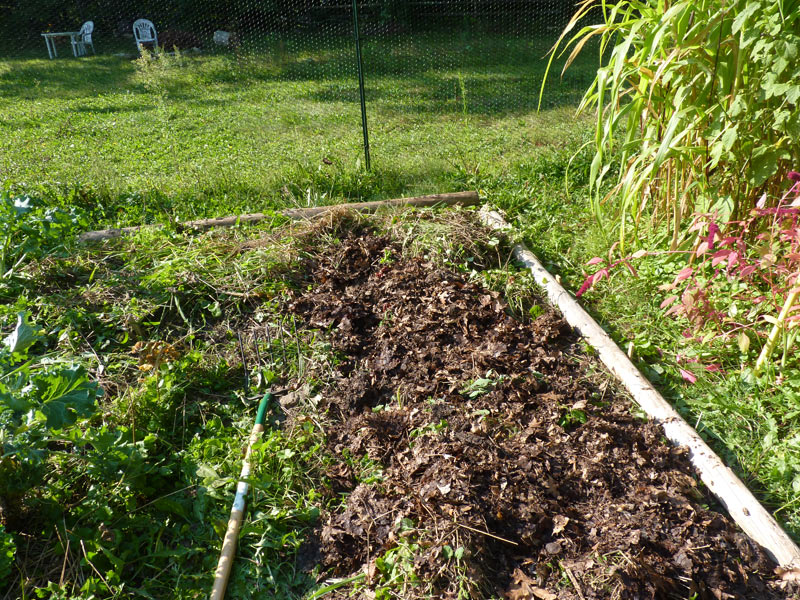A lot of gardeners today use the raised bed method to grow plants. I have been doing pseudo-raised beds in the garden for two years now. The raised beds are higher than the ground (since my local dirt is deficient in a lot of nutrients) and I created them by sheet mulching beds and continuing to add organic matter to them each year. The problem I ran into was simple: a lack of a well-defined garden bed edge means you lose the garden bed edge over time, to plants like ground ivy. So, by Mid-August, even with fairly regular weeding and 4″ or so of straw mulch, my garden beds look like this:

This is actually a bigger problem for anyone who is visiting the garden. When you are doing no-till gardening like I am, its really important that your beds never get stepped on (to avoid compacting the soil). When visitors come, they don’t know where the edge of the beds are, and they step all over them.
I decided to try to create some sides for my raised beds using only found/salvaged materials from the yard. Lucky for me, I’m still looking for uses for the massive amounts of cut cedar logs and broken bricks that the previous owners of this property dumped in the back part of the property. This post will detail how to create a very simple raised bed from these kinds of salvaged materials.
Step 1: Find some logs or bricks or other edging material, enough to line the perimeter of your bed. In my case, I have quite a lot of cedar logs that have been laying outside for a few years, but are still quite good to use. They aren’t good enough to make nice furniture with, but they are great for outdoor projects like raised beds. And before you ask, yes, these logs will eventually rot (although cedar is more rot resistant than some other kinds). This is not a bad thing at all–the rotting wood will add more organic matter to my garden beds, and when they rot down too much, I will simply replace them with more logs or something else I salvage. I have heard of people using treated wood for their raised beds–but what is it treated with, and how might that get into your veggies–and body? Was that wood harvested in a sustainable manner? So using my salvaged cedar logs is a effective way to use the logs, is safe for my organic veggies, and will eventually add important humus to my soil.

Step 2: Do preliminary layout work.
I started by just laying the logs out generally where I wanted them to go (this was after I re-established where my bed edges should have been with a measuring tape!). Even though the bed I’m showing in the photo of was new this year, it still had a lot of ground ivy and I had a hard time finding where the edge was supposed to be. So I measured it out and then laid the logs generally where they should go.
You should also note that, as evident in the pictures, I’m in the middle of adding additional layers of organic materials to prep the bed for the next season (except for where the Kale is growing; I’ll leave that in till the spring assuming the aphids don’t get to it first). When I add organic matter, I add anything that is organic and that I have around: weeds, chicken manure, grass clippings, downed small branches, fallen leaves, old plants that are dead for the season, compost, etc. This will all rot down throughout the fall and spring, and leave me with a wonderful, rich dirt to plant next year’s veggies in!

Step 3: Cut and Trim Logs as necessary.
After you have a decent idea of where your logs should go, you will likely need to do some trimming and cutting to make sure they are the right length. I used a Sawzall for this purpose. I also took the opportunity to cut off any nubs that stuck out too far on the logs so I didn’t trip on them when I was walking through my paths.

Step 4: Dig out a trench and place logs where they should go.
Now that you’ve cut your logs to size, if your beds look anything like mine, you might need to do some weeding work and dig out a small trench for them to sit into (not below ground level, but into the side of the raised bed). I used a combination of a shovel and a hoe to do this work (the shovel for the difficult bits, the hoe for most of it).

Step 5: Secure your logs.
I also found it necessary to secure my logs in place (although I suspect that soon enough the ground ivy and other assorted plants that grow in my paths will secure the logs in place!) I had some cedar shims left over from a different project, and so I pounded them into the ground with a rubber mallet every few feet (breaking off the thinnest portion of the shim). They worked great–and since they are also cedar, they should rot at the same rate as my logs.

Step 6: Add finishing touches and enjoy!
I had a few areas that were smallish, so I used some salvaged bricks and rocks for those edges. But the logs did most of what I needed them to do, and with a few more layers of organic matter and a final topping of organic compost, the beds were prepped for the next season! In the spring and early summer, I’ll report back and let you know how well this method worked!




How do you grow carrots in a no-till garden?
Kullervo,
You have to do one of two things:
1) In my post on sheet mulching (here) you’ll see that I addressed the soil depth issue. You have to make sure your soil is deep enough to handle a long carrot (depending on the size you are growing, say Danvers from Seed Savers Exchange, which really need 10″ or so inches of soil depth. You can do this by first digging out the bed and then adding the sheet mulch. In a couple of years, you should have enough soil amassed regardless. My first year I had carrots hit the bottom of the sheet mulch and not grow any more–but this year, I dug it out and replaced the mulch and the carrots grew really nicely.
2) If you aren’t interested in digging at all, you the other option is to grow a shorter depth carrot, like Paris Market (also from Seed Saver’s Exchange). Soil depth is an issue with any root crop, though, so I really recommend digging out your bed before mulching, at least the 1st year. You shouldn’t have to do it a second time (which would defeat the purpose of no till gardening, haha!)
Reblogged this on freedomveg.
I’m sorry but this post is so stating the blindingly obvious it hardly qualifies as a “how to” piece. How about some suggestions for people who don’t have a pile of suitable logs and shims in their backyard waiting to be “salvaged”??? 🙂
Well, this post was designed to serve as a model. I had a resource, I figured out how to us it :). There is free wood everywhere-lying by the side of the road, people throwing it out, etc. But in terms of suggestions:
1. Look for opportunities to salvage wood–when trees fall, when they are cut and left, etc.
2. Look for wood people are throwing away on the side of the road (old barn boards, etc)
3. Look for wood salvaged from falling in structures, etc.
I hope this helps 🙂